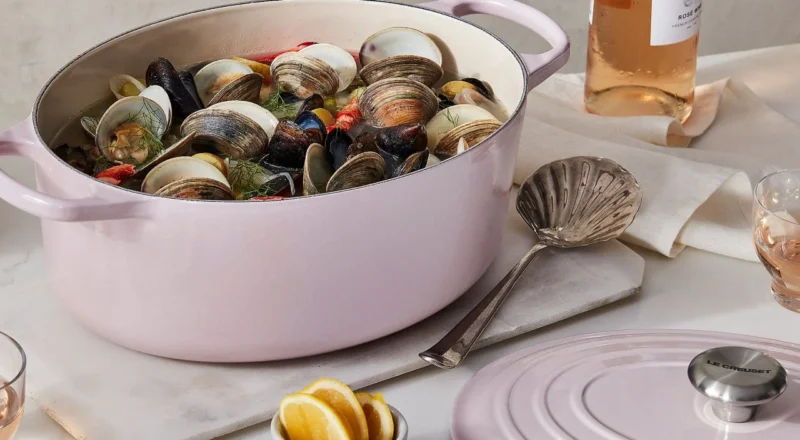Choosing the right cookware can be a daunting task given the variety of options available in the market today. Two popular choices among home cooks and professional chefs alike are the cast iron braiser and the nonstick pan. Each has its own set of features, advantages, and drawbacks that make them suitable for different types of cooking. In this article, we will explore the key differences between a cast iron braiser and a nonstick pan, and help you decide which is better suited for your culinary needs.

Understanding Cookware: Basic Definitions
What is a Cast Iron Braiser?
A cast iron braiser is a versatile piece of cookware that can be used for a variety of cooking techniques including braising, roasting, and frying. Made from heavy-duty cast iron, it typically features a wide base and a domed lid that traps moisture and flavors, making it ideal for slow-cooking meats and vegetables.
What is a Nonstick Pan?
A nonstick pan is a type of cookware that has a coating designed to prevent food from sticking to the surface. This makes it particularly useful for cooking delicate foods like eggs and fish. Nonstick pans are often made from aluminum or stainless steel, with a nonstick coating applied to the cooking surface.
Key Differences
Material Composition
Cast iron braisers are made from solid cast iron, which is known for its durability and heat retention properties. In contrast, nonstick pans are typically made from lighter materials such as aluminum, which heat up quickly but do not retain heat as well.
Cooking Techniques and Versatility
When it comes to versatility, cast iron braisers are hard to beat. They can be used for a variety of cooking methods, including searing, roasting, and baking. On the other hand, nonstick pans are best suited for quick cooking tasks like frying eggs or sauting vegetables.
Heat Distribution and Retention
A key benefit of cast iron braisers is their ability to retain and distribute heat evenly, which is essential for slow-cooking and braising. Nonstick pans heat up quickly but may have hot spots, which can lead to uneven cooking.
Advantages of Cast Iron Braisers
Durability
One of the biggest advantages of a cast iron braiser is its durability. With proper care, it can last a lifetime, making it a worthwhile investment for serious cooks.
Flavor Enhancement
The porous surface of cast iron can enhance the flavors of your food, especially when used over time. This is one reason why many chefs prefer cast iron cookware.
Versatility
As mentioned earlier, a cast iron braiser is incredibly versatile and can be used for a wide range of cooking techniques, from searing to baking.
Advantages of Nonstick Pans
Ease of Use
Nonstick pans are incredibly easy to use, especially for beginners. The nonstick coating ensures that food does not stick to the surface, making cooking and cleanup a breeze.
Healthier Cooking
Because they require less oil or butter, nonstick pans are often seen as a healthier cooking option.
Lightweight
Unlike cast iron braisers, nonstick pans are lightweight and easy to handle, making them a popular choice for everyday cooking.
Drawbacks of Cast Iron Braisers
Weight
Cast iron braisers are heavy, which can make them difficult to handle, especially when full of food.
Maintenance
They require regular seasoning to maintain their nonstick properties and prevent rusting.
Drawbacks of Nonstick Pans
Durability
The nonstick coating can wear off over time, reducing the pan’s effectiveness and lifespan.
High-Heat Cooking
They are not suitable for high-heat cooking, which can damage the nonstick coating.
Which One Should You Choose?
The choice between a cast iron braiser and a nonstick pan ultimately depends on your cooking needs and preferences. If you value versatility and flavor enhancement, a cast iron braiser might be the better choice. However, if ease of use and healthier cooking are your priorities, a nonstick pan could be the way to go.
Conclusion
In conclusion, both cast iron braisers and nonstick pans have their own unique advantages and disadvantages. Understanding these differences can help you make an informed decision about which is right for your kitchen. Whether you opt for the durability and versatility of a cast iron braiser or the convenience of a nonstick pan, both can be valuable additions to your culinary toolkit.
Additional Resources
For more information on cast iron braisers and their uses, you can visit Braiser vs Saute Pan and Cooking Chicken in a Braiser. For insights into how a braiser compares to other cookware, check out Dutch Ovens vs Braisers.

FAQs
Can you use a cast iron braiser for frying?
Yes, a cast iron braiser can be used for frying. Its wide base and excellent heat retention make it ideal for this purpose. For more tips, visit Braiser for Frying.
How do you maintain a cast iron braiser?
To keep your cast iron braiser in good condition, it’s important to season it regularly and avoid using harsh detergents. Always dry it thoroughly after washing to prevent rust.
Is it safe to use metal utensils on nonstick pans?
It’s generally not recommended to use metal utensils on nonstick pans as they can scratch and damage the nonstick coating. Opt for wooden or silicone utensils instead.
This article contains affiliate links. We may earn a commission at no extra cost to you.

